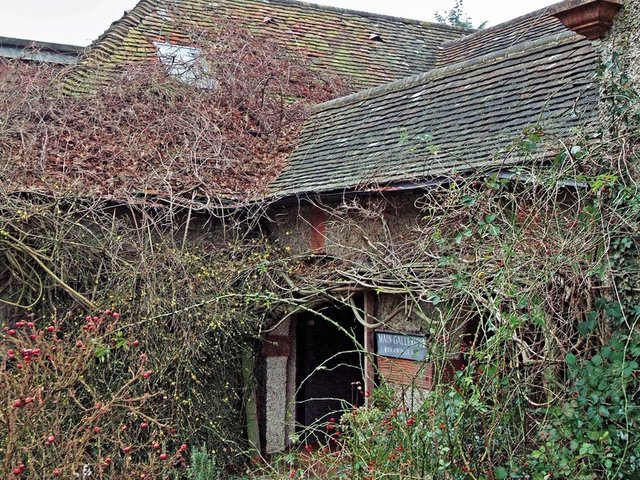Early in February, unseen albums of drawings by the Victorian artist George Fredrick Watts will be shown in London for the first time at the World of Watercolours and Drawings Fair. They are the property of the Watts Gallery, located in the village of Compton in Surrey in the English countryside, which has until now remained a quiet, undisturbed sort of place.
Hidden away off the beaten track, the gallery is only 34 miles from London but seven miles from the nearest post office and impossible to have a newspaper delivered. Its admirers return again and again because they have fallen in love with its sense of timelessness. “This is not the sort of place where you will get ‘the Museum Experience,’” explains its curator, Richard Jefferies. There are no interactive displays, large label panels or historically dressed attendants creating a Watts experience. Instead, the Watts Gallery and its bewhiskered but vibrant curator are an experience in itself. By the time the school parties leave they have had a whale of a time looking not at computer screens, but, for once, at the works of art.
“One of the things they love is discussing how bad some of the paintings are,” chuckles Mr Jefferies. “It hasn’t occurred to children that not everything hanging in a gallery is a masterpiece, and even great artists produce some terrible pictures.”
Built by the great Victorian artist George Frederic Watts (1817-1904), the gallery was designed to house his studio collection and is unique in this country. Nothing like it, honouring a single artist, exists on the same scale. Watts, the son of a penniless maker of pianofortes, rose to the highest levels and helped to found both the National Portrait Gallery and the Tate Gallery. He was a painter-philosopher uninterested in the pursuit of money to whom fame came late in life, the first Social Realist and a marvellous portrait painter. He left an endowment to support the gallery in the belief that art should be for all.
His second wife, the ceramicist, Mary Fraser Tytler (he was first married briefly and disastrously to the pre-Raphaelite beauty Ellen Terry) presided over the gallery for a further 30 years after his death, ensuring that nothing changed. The gallery owns about a tenth of his entire output, 250 paintings, hundreds of works on paper and archival material as well as two magnificent monumental plasters for Watts’s late sculptures, one of his friend Lord Tennyson, the other “Physical energy”, now in Kensington Gardens.
While the gallery’s charm lies in the fact that it remains unchanged, encapsulating the spirit of its great founder, it is so dilapidated that things have now come to a head. It is listed, not for its architectural merits, but because it is one of the earliest, concrete-built buildings constructed in the Arts and Crafts style. “It was incredibly badly built, with no proper damp proofing or insulation in many parts,” explains its curator. Visited on a sodden November day, it had an air of Miss Faversham’s Satis House to it. The roof was leaking, the damp rising, paint and wallpaper peeling and the Victorian heating system struggling to make much impression. The drawings gallery is so damp nothing can be displayed in it.
The time has come for the gallery to brave the modern world and head up a sophisticated appeal for funds. It needs over £5 ($7.9) million to redevelop, build an extension to show works on paper, and bring the building up to modern day museum standards, ensuring its survival and future. The well known collector of Victorian pictures, Christopher Forbes of the Forbes family, one of the gallery’s trustees, has just announced he will donate the proceeds of the sale of a Watts painting. “Orpheus and Eurydice” estimated at £50/£70,000 ($79,100-110,700) from the sale of his family collection in February so the ball is rolling. A group of Watts drawings will be on display at the Watercolours and Drawings Fair from 6-9 February which will introduce many to the gallery for the first time. These are drawn from two albums recently acquired by the gallery which both originally belonged to Watts’s ward, Mrs Michael Chapman. One album was a gift to the gallery from Sir Brinsley Ford through the National Art Collections Fund in 1994, and the second the museum acquired with the help of the NACF in 1999. These have now been conserved and go on show for the first time. They cover the period prior to 1858 with many drawings by Watts between the age of 10 and 20, which show him as an extraordinary prodigy. There are sketches of friends and neighbours, which provided vital family income, studies after famous Old Masters and character studies showing expressions of fear or grief, probably copied from engravings. Much of the material also relates to early works by Watts, many of which are in the gallery’s collection.
The Watercolours and Drawings Fair will be held at the Park Lane Hotel, London, W1, 6-9 February. Opens 11am Thursday-Sunday. Closes Thursday 9pm, Friday 8.30pm, Saturday 6 pm, Sunday 5.30pm. Admission £14 ($22) including catalogue.
Originally appeared in The Art Newspaper as 'Hidden in the English countryside, a Victorian time-warp'


